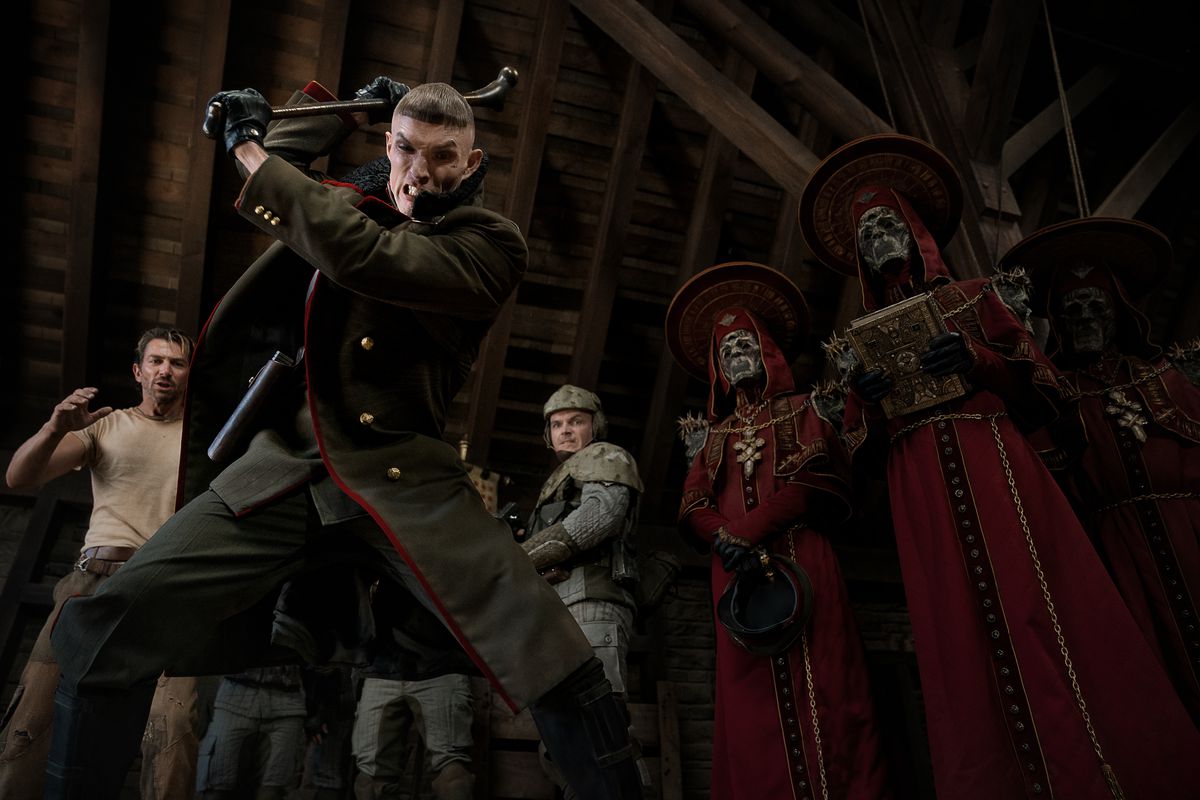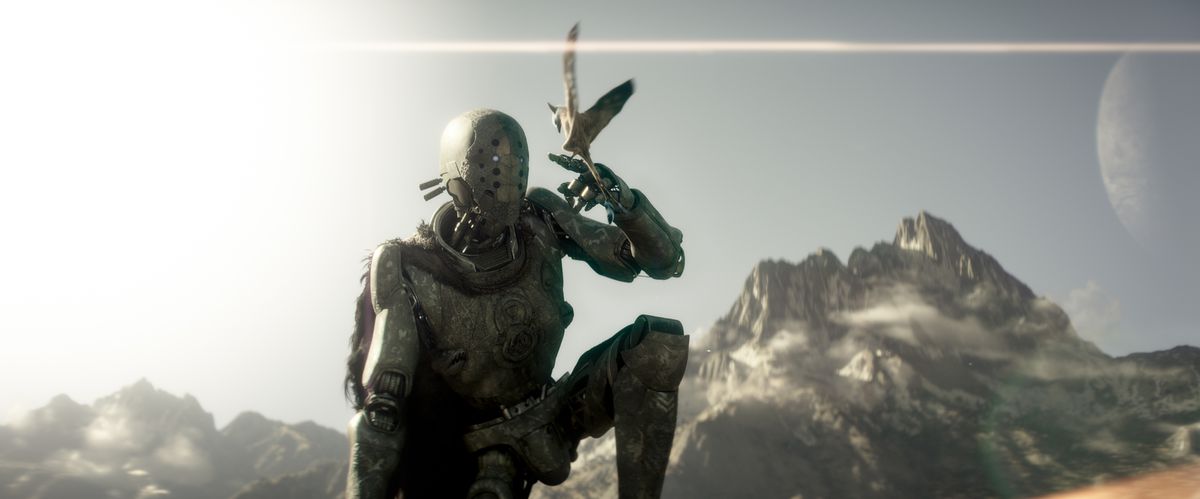The director’s cut of Rebel Moon proves it’s worth a franchise
Let’s start with a really fun part: the teeth.
It’s a beat you might not have noticed at all in the original version of Zack Snyder’s Rebel Moon saga. The only time we really see it up close is when the dastardly Admiral Noble (Ed Skrein) gets a beating at the end of Part 1, and his knocked-out teeth streak across the ground before falling thousands of feet into inky blackness. This being a Snyder film, we see the shot in slow motion, but it reads like a hollow touch of visual flair.
But since this is a Snyder collaboration with a director’s cut, it’s a cloud of brutal poetry that hits much harder in the longer version of the film. It turns out that the priests Noble travels with collect a tooth from each of his victims and artfully place it around a portrait of their murdered princess in some kind of perverse ritual.
It’s metal! The kind of devilishly fun world-building that a major sci-fi blockbuster should have, especially when it’s done by dudes in skull masks and red robes who were mostly in the background in the original. Rebel Moon: A Child of Firereleased last year. In the little close-up glimpses we got of them back then, you could see that there was a lot of detail in their looks, but we never really got to know their deal. That’s the beauty of Snyder’s new director’s cuts of Rebel Moon Parts 1 and 2: It’s a longer look at a world that’s full and rich in a way the original never revealed. More importantly, it feels like the kind of thing you can build an incredibly vibrant franchise on.
Image: Netflix
The bones of Rebel Moon‘s story is the same in both versions: Kora (Sofia Boutella) lives on the remote planet Veldt among a small farming community, hiding from a mysterious past life. But after soldiers from the fascist Empire show up and commandeer all of the village’s grain, Kora is driven back to the violence she was trained for, and she travels the galaxy to recruit a group of soldiers to protect the small town she has come to love. As in the original cuts, A child of fire And The Scargiverit is what it seems: Star Wars meets Seven Samuraiwith some Warhammer elements thrown in for flavor.
But from the start, the recently released director’s cuts — Chalice of Blood And Curse of forgiveness — Filling in what seemed to be lost in Snyder’s vision in the shorter versions. We open with an all-new 20-minute action sequence, set on a planet the originals never set foot on, a world filled with fire and blood in a final battle against the Empire. The sheer amount of splatter and nudity here makes it clear that this is not your father’s movie Rebel Moon; this is an R-rated film in full Snyder technicolor. And remarkably, it all feels quite fluid: it’s hard to imagine Rebel Moon without this first glimpse into Noble’s moral deceit, to appreciate his killing a Veldt villager with the sacred bone staff, or the cruel rituals of his priests. As we come to understand (and as Rebel Moon will turn over and over again), Noble and his troops are brutal without honor, untrustworthy, and barbaric on principle. It’s an important undercurrent, one that was lost in the originals where they were simply “The Very Worst.”

Photo: Clay Enos/Netflix

Image: Netflix
And this continues in the director’s cuts, with dozens of small, extra scenes that build toward bigger reveals and more lavish world-building. Nowhere is this truer than with Jimmy, a robot voiced by Anthony Hopkins whose journey is strangely sidelined in the original cut. He’s a model android originally designed to defend the royal family, but now repurposed as a manual laborer after they all mysteriously refused to fight after the tragic deaths of their charges. Chalice of Blood checks in with him much more often than Child of Fire did so, and spoke of his retreat into nature to discover himself at the emotional core that underpins everything Kora and her merry band of rebels fight against.
Like all things Snyder, the result is passionately honest; a story about what it means to fight for what you care about, what you believe in, what you deserve, and what you think you’ll never earn. And like all things Snyder, the whole thing feels like a beautiful enigma. Watching the original versions, it’s clear that they’ve been hampered by try to be two-hour movies, according to Netflix guidelines. And when you watch the extended versions, it’s clear that this story was probably best served by the single four-hour film Snyder originally conceived. While Chalice of Blood feels like the relatively smooth, action-packed three-and-a-half-hour get-the-gang-back-together adventure we’d expect from the minds behind the Snyder Cut of Justice League, Curse of forgiveness is a bit behind the times as it jumps back and forth between backstory, combat and barley farming. Taken as a whole, the director’s cuts of Rebel Moon are too many. If you watch them as two separate films in a series, you can see how the hoops obstructed the view.
The dilemma of every Snyder film begins with the buy-in the audience is willing to give to long running time and the pleasures those extra minutes allow. And in Rebel MoonThey certainly give way to many of Snyder’s weaknesses as a filmmaker, particularly the way that aesthetic demands can often render certain feelings more inert than they should be. Boutella’s Kora is the film’s ostensible heart, but she’s far more capable in action than deep in her emotions. It’s hard to believe in the story’s commitment to love that conquers all when there’s not much chemistry to speak of. But the director’s cut’s R rating at least means that the sex scenes can give Boutella back the physical prowess that the forged dialogue might rob her of.
But if you can tolerate Snyder’s mannerisms – and I think you should – then Rebel Moon director’s cuts are a testament to his creative prowess. While the world clearly evokes other, stronger films with its references, it never feels like a rip-off. (Even the obvious “lightsaber” blades feel distinctly his own.) Every plot twist is as clumsy as it is artful, full of imagination and small details.
It’s a vast, new world, and one that gets better with every new Jimmy soliloquy, or human bar patron actually being served by a crustacean alien. More character shines through the cracks in Rebel Moon that allows for the sheen of most, more polished modern blockbusters. And unlike modern Star Wars, the vastness of the universe feels like an opportunity rather than a gestured lore.
While I could argue about a choice here and there, the failures of Rebel Moon small and human feeling, an imagination bursting with potential and missing a few beats here and there. Ultimately Chalice of Blood ends with a stronger promise for future episodes than Curse of forgiveness delivers, but even with long playtimes and ample side quests, it never feels like Snyder is taking on more than he can chew. The opposite is true: Nor Rebel Moon is perfect, but I’m totally ready to dive into it even more.
All four versions of Rebel Moonincluding the final director’s cuts Part 1 – Chalice of Blood And Part 2 – Curse of Forgiveness are now on Netflix.
